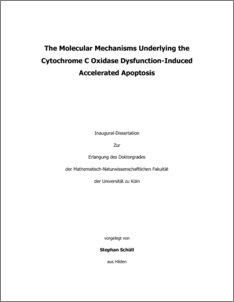Schüll, Stephan
(2014).
The Molecular Mechanisms Underlying the Cytochrome C Oxidase Dysfunction-Induced Accelerated Apoptosis.
PhD thesis, Universität zu Köln.

![[img]](https://kups.ub.uni-koeln.de/style/images/fileicons/application_pdf.png)  Preview |
|
PDF
Doktorarbeit_Stephan_Schuell_Endversion_Bibliothek.pdf
Download (2MB)
|
Abstract
Apoptosis, the physiological cell death, is an essential component of cellular homeostasis and tissue regeneration, and the dysregulation of apoptosis culminates in multiple human diseases. Whereas the failure to execute timely programmed cell death in renovating tissues contributes to cancer, excessive apoptosis in post-mitotic tissues precipitates degenerative states, aging and aging-associated diseases.
Research work within the last two decades has shown that tissue degeneration caused by mitochondrial oxidative phosphorylation (OXPHOS) defects is associated with excessive apoptosis. However, it is unclear how OXPHOS-dysfunctions interfere with the apoptotic machinery and how this impacts on tissue degeneration.
In this context we demonstrate that solely the chemical induction of cytochrome c oxidase (COX) deficiency, which is among the most common defects found in mitochondrial diseases, exclusively and dramatically increases the Bcl-2 dependent apoptotic response towards oxidative stress. Furthermore, we could widen and reconfirm our findings in COX-deficient cybrids harboring an mtDNA-encoded deletion of COX subunit I as well as in murine fibroblast devoid of COX-assembly factor COX10. These findings indicate a general mechanism of COX-deficiency induced apoptosis by oxidative stress. Moreover, our data highlight that COX-deficiency is accompanied by an increased de novo synthesis and accumulation of the sphingolipid species ceramide. Due to their chemical properties especially ceramides with an acyl side-chain length of C16:0 have conclusively and repeatedly been demonstrated to induce apoptosis by pore-formation and by contributing to pro-apoptotic Bax and Bak induced permeabilization of the mitochondrial outer membrane (MOMP). Correspondingly, we show that the inhibition of endoplasmic reticulum-resident specific ceramide synthases abrogates enhanced apoptosis induced by mitochondrial respiratory chain-dysfunction. In particular, we identify ceramide synthase 6 (CerS6) as the key mediator of C16:0 ceramide induced apoptosis to oxidative stress: While down-regulation of CerS6 protects COX-deficient cells from oxidative stress, overexpression of CerS6 introduces susceptibility towards oxidative stress in COX-functional cells.
In summary, our findings identify ceramide accumulation and in particular CerS6 as important components of the apoptotic response of COX-deficient cells towards oxidative stress and provide new insights into how mitochondrial dysfunction interferes with the apoptotic machinery and may impact on tissue homeostasis.
| Item Type: |
Thesis
(PhD thesis)
|
| Translated abstract: |
| Abstract | Language |
|---|
| Apoptose, besser bekannt als physiologischer Zelltod, ist ein wichtiger Bestandteil der Zell-Homöostase sowie der Geweberegeneration. Ein Ungleichgewicht im physiologischen Zelltod kann die Entstehung multipler Krankheiten beim Menschen begünstigen. So ist beispielsweise eine verminderte oder gänzlich reduzierte Apoptose ursächlich für die Entstehung von Krebs, wohingegen exzessive und deregulierte Apoptose in postmitotischen Gewebe zu degenerativen Krankheiten bzw. altersbedingten Krankheitserscheinungen führen kann.
Die Forschungsarbeit der letzten zwei Jahrzehnte hat aufgezeigt, dass die Gewebedegeneration aufgrund defekter mitochondrialer oxidativer Phosphorylierung (OXPHOS) mit erhöhter Apoptose assoziiert ist. Hierbei ist jedoch unklar, wie genau sich Störungen der OXPHOS auf den Wirkungsmechanismus der Apoptose auswirken und wie dies dann zur Gewebedegeneration beiträgt.
In diesem Zusammenhang können wir zeigen, dass ausschließlich der durch chemische Inhibition hervorgerufene Defekt der Cytochrome C Oxidase (COX), eine der am häufigsten auftretenden Defekte bei mitochondrialen Erkrankungen, ursächlich für eine erhöhte Bcl-2 abhängige Apoptose aufgrund von oxidativem Stress ist. Diese Befunde konnten durch weitere Untersuchungen in einer COX-defizienten Cybridlinie, welche einen mitochondrial-kodierten Defekt der strukturellen COX-Untereinheit I enthält, sowie in murinen Knockout-Fibroblasten des Assembly-Faktors COX10 bestätigt und untermauert werden. Unsere Untersuchungen deuten daher auf einen generellen Wirkungsmechanismus der durch COX-Defizienz induzierten Apoptose nach oxidativem Stress hin.
Des Weiteren belegen unsere Untersuchungen, dass Defekte der COX mit einer erhöhten de novo Synthese und der Anhäufung von Ceramiden einhergehen. Für Ceramide, insbesondere solcher mit einer C16:0 Seitenkette, konnte in der Vergangenheit wiederholt gezeigt werden, dass sie bei der Permeabilisierung der äußeren mitochondrialen Membran (engl. MOMP) mittels der pro-apoptotischen Proteine Bax und Bak eine wichtige Funktion als Porenbildner einnehmen. In diesem Zusammenhang zeigt die hier vorliegende Arbeit, dass die durch oxidativen Stress hervorgerufene Apoptose in COX-defizienten Zellen durch die Blockade der sich am endoplasmatischen Retikulum befindenden Ceramide-Synthasen vollständig aufgehoben werden kann. Insbesondere können wir hierbei zeigen, dass die Ceramide-Synthase 6 (CerS6) eine Schlüsselrolle in der Apoptose von COX-defizienten Zellen auf oxidativen Stress einnimmt:
Während eine Verminderung der CerS6-Expression in COX-defizienten Zellen vor oxidativem Stress schützt, bewirkt die Überexpression von der CerS6, dass normal respirierende Zellen ohne COX-Defekt gegenüber oxidativem Stress anfällig werden.
Zusammenfassend zeigt die vorliegende Arbeit, dass die Akkumulation von Ceramiden sowie die CerS6 essentielle Bestandteile der durch oxidativen Stress-induzierten Apoptose in Zellen mit defekter COX sind. Unsere Arbeit ermöglicht neue Einblicke in die Auswirkungen von mitochondrialen Defekten auf den Prozess des physiologischen Zelltods und wie sich dies auf die Gewebe-Homöostase auswirken könnte. | UNSPECIFIED |
|
| Creators: |
| Creators | Email | ORCID | ORCID Put Code |
|---|
| Schüll, Stephan | stephan_schuell@web.de | UNSPECIFIED | UNSPECIFIED |
|
| URN: |
urn:nbn:de:hbz:38-57725 |
| Date: |
2014 |
| Language: |
English |
| Faculty: |
Faculty of Mathematics and Natural Sciences |
| Divisions: |
Faculty of Mathematics and Natural Sciences > Department of Biology > Institute for Genetics |
| Subjects: |
Life sciences |
| Uncontrolled Keywords: |
| Keywords | Language |
|---|
| Cytochrome C oxidase; apoptosis; sphingolipid | UNSPECIFIED |
|
| Date of oral exam: |
21 May 2014 |
| Referee: |
| Name | Academic Title |
|---|
| Rugarli, Elena | Prof. Dr. | | Wiesner, Rudolf | Prof. Dr. | | Schwarz, Günter | Prof. Dr. |
|
| Refereed: |
Yes |
| URI: |
http://kups.ub.uni-koeln.de/id/eprint/5772 |
Downloads per month over past year
Export
Actions (login required)
 |
View Item |


